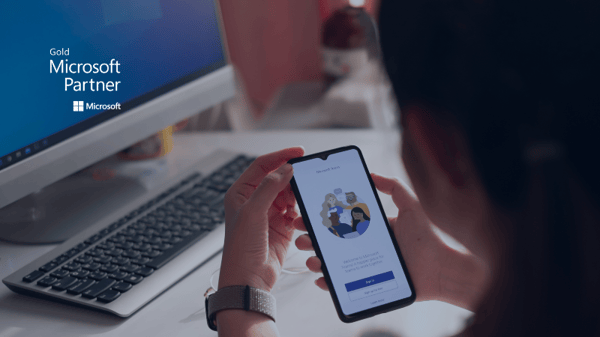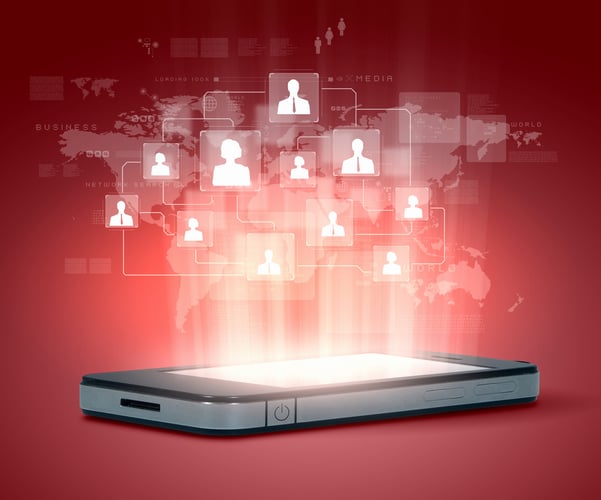Introduction - Today's Best Call Center Phone Systems
Microsoft Teams Phone System
Microsoft Teams Phone System is a collaborative communications app that serves as a home base for your team to stay connected, up-to-date, and engaged on projects.
RingCentral Intro
RingCentral is a cloud-based program that offers a phone call center, video conferencing, and instant messaging through one integrated system.
Microsoft Teams Phone System
Microsoft Teams Phone System offers the same qualities of Private Branch Exchange (PBX) within the Microsoft 365 cloud.
Phone System works with Teams members and recognized devices, handling calls internally within the system and avoiding long distance fees for internal calls.
For external calls, add-on options are available by connecting Phone System and the Public Switched Telephone Network (PSTN).

Microsoft Teams Phone System Features
Phone System covers all the basics of making, receiving, transferring, muting, and unmuting calls within the same collaborative space that video calls, messaging, sharing and storing documents with your team, and more, take place.
The call center system can be accessed via mobile device, laptop or PC, or any other device that works with Teams, with the ability to transfer between devices during a call without interruption.
Phone System offers caller ID and spam call identification, Apple CarPlay support, one-to-one call record and transcription, and a relatively new walkie-talkie-like function on desk phones to allow for quick contact between colleagues.
Other features include cloud auto attendants, call ques, default or custom music on hold, call forwarding, call park and retrieve, integrated search bar and dial pad, call blocking, and cloud voicemail.
(Features list below directly from Microsoft)
|
Phone System feature |
Description |
|
Lets you create a menu system that enables external and internal callers to locate and place or transfer calls to company users or departments in your organization. Note that users do not need to be voice enabled to receive calls from the auto attendant dial by name, dial by number directory search. Users do need to be voice enabled to receive calls from the auto attendant menu options. |
|
|
Lets you configure how call queues are managed for your organization: for example, set up greetings and music on hold, search for the next available call agent to handle the call, and so on. Note that users do need to be voice enabled to receive calls from a call queue. |
|
|
Plays default music defined by the service or custom music uploaded by the tenant administrator when an external call from the Public Switched Telephone Network (PSTN) is placed on hold. This feature works for one-to-one PSTN-to-Teams calls in addition to calls made to a call queue. This feature provides on-hold notification parity with other platforms. |
|
|
Call answer/initiate (by name and number) |
Lets users answer inbound calls with a touch, and place outbound calls either by dialing the full phone number or by clicking a name in the client. |
|
Lets users set up forwarding rules so calls can go with them anywhere, or calls can be forwarded to colleagues or to voicemail. |
|
|
Lets users share incoming calls with colleagues so that the colleagues can answer calls that occur while the user is unavailable. Less disruptive to recipients than other forms of call sharing (such as call forwarding or simultaneous ringing) because users can configure how they want to be notified of an incoming shared call. |
|
|
Lets users transfer calls to another person. Or, if they need to leave their office but want to continue the conversation, they can transfer the calls from their PC or IP phone to their cell phone. Note that users do not need to be voice enabled to receive transferred calls from another user. |
|
|
Lets users transfer to voicemail during a call. |
|
|
Lets users place a call on hold in the Teams service in the cloud. When a call is parked, the service generates a unique code for call retrieval. The user who parked the call or someone else can then use that code and a supported app or device to retrieve the call. |
|
|
Call phone number from search |
Lets users place a call from the search box by using the /call command and specifying a name or a number. |
|
Calls from inside the company display a detailed caller ID that pulls information from the corporate directory, showing picture ID and job title instead of just a phone number. For calls from external phone numbers, the caller ID as provided by the phone service provider is displayed. If the external phone numbers are secondary numbers in the corporate directory, then the information from the corporate directory will be displayed. |
|
|
Device switching |
Lets users play a call or meeting on another HID device that is connected to Teams; for example, switching from their PC speakers to a headset. |
|
Presence-based call routing |
Controls inbound communications with presence, enabling the user to block all incoming communication except from those specifically indicated. |
|
Lets users dial by name or by number anywhere in the search bar and in the dial pad, speeding up the process of making outbound calls. |
|
|
Federated calling |
Lets users securely connect, communicate, and collaborate with users in federated tenants. |
|
If the user's account is enabled for video calls, the user can make face-to-face video calls with their contacts. All they need is a camera, their computer’s speakers and microphone. Users can also use a headset if their computer doesn’t have a built-in audio device. |
|
|
When a user receives a voicemail, it is delivered to their Exchange mailbox as an email with the voicemail message as an attachment. Users can listen to their messages on their certified desktop phone, and on all Teams or Skype for Business applications. Support for voicemail transcription has been added as of March 2017 and is enabled by default for all organizations and users. Note that users do not need a Phone System license, nor do they need to be voice enabled to use Cloud Voicemail features. |
|
|
Lets users configure their client settings for voicemail greetings, call answering rules, and greeting language, including out-of-office greetings. Note that users do not need a Phone System license, nor do they need to be voice enabled to use Cloud Voicemail features. |
|
|
Users with multiple speaker devices connected to their PC can choose to set a secondary device to ring in addition to their default speaker. For example, a user with a headset connected to the PC and desk speakers can choose to have both headset and desk speakers ring when a call comes in so that they don’t miss a call. |
|
|
Distinctive ring alerts (Teams only) |
Lets users choose separate ringtones for normal calls, forwarded calls, and delegated calls so they can distinguish the type of call. |
|
Lets users share their phone line so that another user can make and receive calls on their behalf. |
|
|
Busy on Busy (Teams only) |
A calling policy that lets you configure how incoming calls are handled when a user is:
The caller will receive one of the following responses:
The callee gets a missed call notification but isn't able to answer incoming calls. This feature is disabled by default, but can be turned on by the tenant admin. |
|
Lets users add (PSTN) phone numbers to a blocked list so that the next call from that number is blocked from ringing the user. |
|
|
A common area phone is typically placed in an area like a lobby or conference room making it available to multiple people. Common area phones are set up as devices rather than users, and can automatically sign into a network. |
|
|
Media bypass support (for Teams Direct Routing only) |
For better performance, media is kept between the Session Border Controller (SBC) and the client instead of sending it through the Phone System. |
|
Allows routing of unassigned numbers to users, auto attendants, call queues or a custom announcement. |
Microsoft Teams Phone System Pricing
Phone and video calls to other Microsoft Teams members are free of charge, but if you want to be able to contact regular phones and don't have an existing service provider, you need to purchase a Calling Plan.
A calling plan provides customers with a primary phone number and calling minutes to make and receive phone calls.
Understanding Microsoft Teams Phone system pricing can be a little complex because of various ways to connect your PSTN to Teams.
Your calling plans will differ depending on whether you’re accessing calling functionality directly from Microsoft Teams or a Direct Routing or Operator Connect provider.
Calling Plans options:
- Domestic Calling Plan: Licensed users can call numbers located in the country/region where they are assigned in Microsoft 365 or Office 365.
- International Calling Plan: Licensed users can call numbers located in the country/region where they are assigned in Microsoft 365 or Office 365 and to international numbers in nearly 200 countries/regions.
Users in the same country/region (as designated in the licensing area of the Microsoft 365 admin center) with the same Calling Plan share a pool of minutes.
For example, if you have 100 users located in the same country/region with a 120 minutes Domestic Calling Plan, they share a pool of 12,000 minutes. All calls exceeding these minutes are billed per minute.
Pricing ranges from $8 per month per user to $57 per month per user based on the plan and existing Microsoft business license being used. Exact features vary based on the plan and can be found here: Microsoft Teams Phone Pricing
For discounted pricing, use a trusted Microsoft Gold Partner and award-winning Managed Services Provider (MSP) like Datalink Networks.
Microsoft Teams Phone System Migration & Setup
The prerequisites for using this phone system are as follows:
- Microsoft Business Voice license – Activate from the 365 admin center
- A calling plan – Available starting at $15 per user per month for the Microsoft Teams Phone with a calling plan package
- PSTN connectivity – Instead of buying phone numbers from Microsoft under the Calling Plan, you can stay with your existing PSTN carrier
- Direct Routing – Microsoft 365 Phone System with PSTN requires direct routing to connect the public network and the cloud
RingCentral Phone System
RingCentral Phone System was founded in 2003 by David A. Gurry and Stanley M. Brown Jr., with the goal to "build the most powerful and reliable communications platform for business." The company's headquarters are in Santa Clara, California.
RingCentral Phone System is a cloud-based phone system that lets you manage your business from anywhere. It offers a variety of features including voicemail, call routing, conference calling, faxing and much more.
RingCentral Phone System is an all-in-one solution for businesses that need to make calls on the go or have remote employees

RingCentral Phone System Features
RingCentral offers a cloud-based phone system that enables business owners to make and receive calls, send and receive faxes, and manage their contacts from anywhere at any time.
RingCentral’s expensive feature set has made it a popular tool among mid to large sized businesses. The feature set can be broken down into these categories:
- Calling and Mobility
- Administration
- International
- Video
- Message
- Security
- Analytics
Calling and Mobility
RingCentral allows businesses to use a wide variety of available phone numbers and call from various devices (phones, tablets, desktop, etc.). Additional features make RingCentral an ideal choice for a wide variety of businesses.
Local numbers
RingCentral allows businesses to utilize numbers in over 200 available area codes. Customer calls can be directed to a single number and/or direct calls into a call queue.
Toll-free and vanity numbers
Businesses can choose to utilize toll-free numbers or vanity numbers. Toll-free numbers can give your business immediate credibility and trust. Choose from 800, 888, 877, 866, 855, or toll-free vanity numbers.
Extensions
Extensions build a flexible structure that can link employees to central and/or satellite offices or even to remote locations.
Presence and head-up display
No matter where you are, you can see employee statuses of Available, Invisible or Do Not Disturb on your desktop or mobile app.
Call delegation
Call delegation is an easy, visual way for an admin assistant to place calls on behalf of executives. This can simplify the call transfer process and ease the workload for executives who handle a high volume of calls.
Call screening
Choose who can reach your business. Take calls from particular callers, block specific numbers, and send others directly to voicemail.
Call forwarding
Take calls from anywhere. Call forwarding allows users to take calls 24 hours a day from nearly any place in the world.
Call flip
Call flip allows users to transfer calls between devices with ease.
Call park
Call park allows users to hold calls at a virtual terminal and transfer calls to any phone in the system.
Administration
RingCentral’s advanced administrative and analytics tools allow admins to provision, manage and gain insights.
Cloud PBX
Revolutionizes the office phone system at a fraction of the cost of traditional PBX hardware systems.
Greetings
Telephone greetings can help establish your company’s brand and enhance its image.
Multi-level IVR
Expand the capabilities of your automated attendant system that connects employees with self-service access.
Music on hold
Play music while callers are on hold.
Dial-by-name directory
Find employees with the easy-to-use directory. This gives any business a Fortune 500 feel.
Number porting
Easily transfer an existing number into the RingCentral directory in a few simple steps.
Multi-site management
The multi-site feature allows admins to easily manage and support branch locations based on individual operational needs.
Call monitoring
Authorized employees can listen in on client calls for coaching, feedback and/or to facilitate discussion.
Call logs
RingCentral logs all inbound and outbound calls with name, date, time, duration and the number and/or extension dialed.
International
RingCentral offers comprehensive service in over 40 countries, and it offers full service and incoming virtual numbers in over 100 countries. Eliminate the cost and complexity of managing multiple different phone systems and enjoy simplified number management and international device shipping.
Global MVP™
Simplify a global workforce by having all employees use one central, cloud-based phone system.
International calling
Benefit from free extension-to-extension calling for all office-to-office calls. RingCentral also offers low rates on any other international call.
International numbers
Expand your global presence with international numbers, available in 70 countries with geographic toll-free number availability.
Video
HD web-based audio and video offer RingCentral users great video conferencing capabilities.
Video conferencing
Conference with up to 500 people worldwide using HD video and audio. Boost efficiency with one-click screen sharing from mobile and or desktop devices.
Audio conferencing
Conference with up to 1,000 people worldwide using HD audio with local dial-in support.
Cloud telepresence
Connect and collaborate with one-click from any device in any conference room.

Messaging
Improve efficiency with direct and group messaging, fast file transfers and much more.
Team collaboration
Team collaboration with RingCentral is better, faster and more productive.
Business SMS and MMS
Send text messages directly from your RingCentral number.
Message alerts
Receive notifications for texts, voice and fax via email and SMS.
Security
RingCentral has 7 layers of security to keep you insulated from any and all cyber attacks.
Secure VoIP service
RingCentral provides secure VoIP from anywhere in the world with an internet connection.
Single sign-on
Users can automatically sign in to RingCentral using their company credentials. Reduce IT costs to help users recover passwords and benefit from a single point of authentication for secure access to RingCentral services from any device.
Data center overview
RingCentral has 17 data centers across four regions and focuses on providing enterprise-grade support using 45 direct peering connections with Tier 1 international carriers on over 200 ISPs.
Roles and permissions
Admins can create roles and control permissions within each role. This provides admins with a flexible and efficient way to onboard new employees to the RingCentral system.
Analytics
Admins can customize and manage KPIs from a custom or pre-built (over 30 pre-built templates) dashboard.
Analytics portal
Consolidate data and render visualizations detailing reports.
Performance reports
Admins receive up-to-date reports on various currency indices. Performance reports support over 30 pre-built KPIs such as missed voicemail calls, average response rate and bounced calls.
QoS reports
See how your local network, Internet connection, and router all affect your overall call quality. RingCentral provides tools for checking connectivity and configuring router Quality of Service (QoS) settings.
Live reports
RingCentral live reports provides easy-to-understand dashboards that provide actionable insights into agent performance and the overall customer service experience.
RingCentral Phone System Pricing
There are four pricing plans for RingCentral: Essentials, Standard, Premium and Ultimate.
Pricing through RingCentral ranges from $19.99 per user per month for the Essentials plan to $59.99 per user per month for the Ultimate plan.
The available features vary based on the plan and can be seen on RingCentral’s website here: RingCentral Pricing
Datalink Networks exclusive MSP pricing can help reduce licensing costs. Contact a Datalink Networks VoIP expert for the best deals on RingCentral call systems.
RingCentral Phone System Setup
RingCentral offers a free demo to potential customers, so they can see first-hand how the system works. The company also offers two options for setup: self-installation or installation by a professional technician.
A trusted technology partner, like Datalink Networks, can help perform a correct, speedy installation.
When using an MSP like Datalink Networks to perform on-site installation, costs are often offset by the savings businesses receive on licensing costs.
To learn more about VoIP installation, speak to a Datalink Networks VoIP pro today!

Conclusion
Microsoft Teams Phone System and RingCentral are two of the best enterprise phone systems available on the market today. Both systems offer very similar functionality and additional features.
As a standalone service, RingCentral has the slight edge. However, Microsoft Teams Phone System is an add-on to the expansive Microsoft Office 365 suite.
Our recommendation is, if you are already a Microsoft office customer, use the Teams Phone System, but if you are not currently using Microsoft, it is worth pricing out the RingCentral system.
To learn more about these systems and get comparative quotes, speak to a VoIP expert today.



